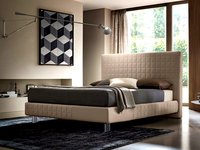Commercial
FIELDS OF APPLICATION
In recent years, digitalization has revolutionized the nature and organization of office
work; today, also the realization of the technical plants of a building is changing in a
profound way. It is the case of the illumination: a control based on the most recent
digital technologies is able to offer a performance unthinkable in the past, and takes
into account not only the visual, but also the emotional and the biological point of view.
In many cases, lighting can express a new company culture, focusing on people and
their needs, thus creating the best work conditions. It is not hard to understand the
reasons: employees and their know-how represent the most important asset for a
company and, at the same time, the most relevant cost. Those who invest in the health
and well-being of their own employees will see the advantages in a surprisingly short
time. In fact, a good illumination makes it easier to focus and reduces fatigue, thus
increasing well-being and productivity. But it is not limited to that: it also respects
the people’s biological rhythm, it regulates according to the personal needs, inspires
individual creativity: in short, it contributes to a high-quality environment.
Illumination as a design tool
In a world where most people in the developed countries are employed in activities
based on information and knowledge, the office becomes a meeting point, a place to
exchange information and ideas, of communication and creativity. A place evolving
through time to keep track of the constant organizational changes. An optimal design
of the workplace plays a key role, combining technical, economical and social aspects:
illumination is at the center of this process. Light becomes the tool par excellence
in designing environments, like furniture or acoustics: it should come as a surprise,
because first of all light creates atmosphere.
More possibilities
Traditional lighting systems are characterized by a complete immobility and are not
able to fulfill the requirements of commercial buildings: devices constantly switched
on in unoccupied environments, lights fully on of off without intermediate situations,
always the same color temperature of the light sources until their replacement, ne-
cessity to modify the wiring in case of space reconfiguration are only a few examples
of that. Only flexible and smart systems can embrace the changes of both work or-
ganization and architectonic spaces, adapting through time with the dynamicity that
traditional system cannot offer. Light designers can then exploit natural light, adap-
ting in a creative way different tones of light and color, devising lighting scenes and so
much more, while owners and managers can take advantage of a more efficient use of
energy and offer the best possible conditions to the occupants.
Luce di qualità
Per una luce autenticamente di qualità, il controllo deve considerare tre
dimensioni:
• la qualità visiva: una buona luce è il prerequisito per una visione senza
problemi e il riconoscimento dei compiti visivi, compresi quelli lavorativi;
• la qualità emotiva: le componenti di luce naturale e artifi ciale fanno parte
integrante dell’architettura e dell’ambiente di lavoro, creando atmosfera e
benessere;
• la qualità biologica: la luce regola il bioritmo delle persone, sincronizza
le fasi di veglia e di sonno e ha una grande infl uenza sulla salute e sulle
prestazioni lavorative.
99
98







